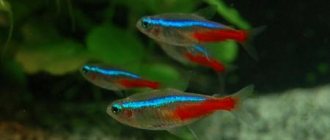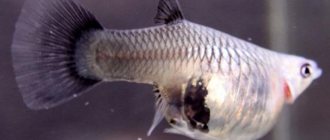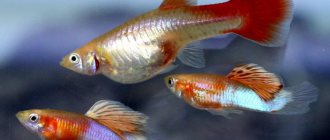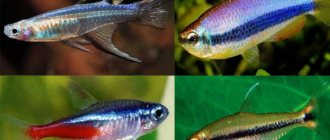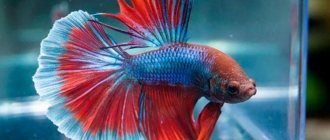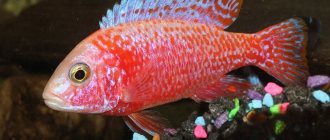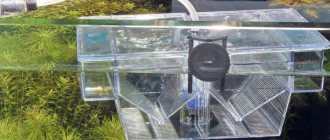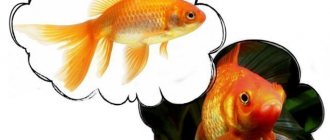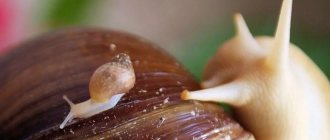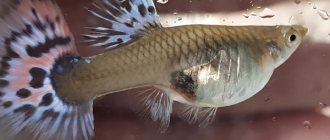Neons are small, beautiful, active aquarium fish that reproduce by spawning. Neons reach sexual maturity at the age of 6-8 months and retain reproductive functions until 4-5 years. To get offspring from these fish, you need to create special conditions for them. If everything is done correctly, you can see how neon fish reproduce. The most favorable time for spawning is from October to January.
Selection of producers and their preparation for spawning
For spawning, it is necessary to select the most promising representatives of the flock. The selected fish must have a healthy appearance, high mobility and bright coloring.
Females and males are distinguished according to the characteristics indicated in the following table.
| Differences between female and male neons | ||
| Characteristic sign | Males | Females |
| Size | More miniature | Larger ones |
| Stomach | Flat | Round, especially before spawning |
| neon stripe | Straight | With a break in the middle |
Females can spawn every week; males can produce milk twice a month. In individuals ready to reproduce, sexual demorphism is especially pronounced: in males, the swim bladder stands out and moves towards the anus, in females the abdomen enlarges and is rounded.
At least two weeks before spawning, future spawners should be isolated from the flock and placed in different containers. During this period, the male and female should be fed intensively and variedly with live food.
ATTENTION: It is advisable to include daphnia, cyclops and small bloodworms in the diet of future breeders. It is better to avoid enchytraeus and tubifex plants. The temperature of the water in the containers should be reduced to 20°C.
Return to content
Male
Differences between the sexes
At rest, neochiki almost do not differ in gender. But during spawning, the differences between male and female are more obvious.
The gender of a fish can be determined by the following characteristics:
- the male individual is approximately 5 mm smaller than the female;
- the blue (neon) stripe running through the entire body of the male has clear, even outlines, while the female has a stripe with a bend starting closer to the middle of the body;
- females are more rounded in shape and have an enlarged abdomen.
Preparing the spawning tank
While the female and male are preparing for spawning, it is necessary to prepare a spawning tank for them - a small aquarium or an all-glass container with a volume of 6-10 liters, which is easy to wash and disinfect. It is best to use an elongated aquarium about 40 cm long for this. The prepared container should be disinfected with a weak solution of potassium permanganate, and then rinsed thoroughly with clean water.
The walls of the spawning area should be shaded with old newspapers or thick paper. You can leave the front surface of the vessel open and watch the fish spawn through it.
The light in the spawning tank should be dim and not directed. The top of the vessel should be covered with a glass lid, since during mating the fish are very active and can jump out of the container.
There is no need to pour soil into the spawning tank; it is best to put a piece of Java moss, a nylon mesh, tangled fishing line, a washcloth or willow roots collected in water on the bottom. You can attach several bushes of cryptorina or fern to the bottom.
IMPORTANT: Catfish and snails, which will happily feast on fresh eggs, should not be allowed into the spawning area. In a short time they can clear all the internal surfaces of a reservoir of eggs.
Return to content
DESCRIPTION, APPEARANCE, BUILDING
Neons are highly prized among aquarists. These fish are a real decoration for an aquarium. There are bright neon stripes on their body. Despite the bright colors, the fish do not distract, but, on the contrary, emphasize the beauty of the design created in the aquarium.
Neons are schooling fish and look great in an aquarium. Their bright shiny red or blue stripes along the body flash spectacularly in reflected light. This distinctive feature, which gives the fish a resemblance to neon signs, was the idea for their name.
The body of the fish is elongated and slightly flattened on the sides. On average, the length of neons is from 2.5 to 5 cm. The fish have a relatively small mouth, transparent fins, of which the anal one is longer than the dorsal one. Fishes of the order Characinidae are characterized by the presence of an adipose fin. It has no bony rays. The adipose fin is not paired and is located behind the dorsal fin.
It is noteworthy that in males the neon stripe is a straight line, while in females it has a slight break in the middle. Therefore, a specialist can easily distinguish a male from a female.
Most often in aquariums you can see red, blue and black neons.
black neon
red neon
blue neon
Requirements for water composition
Neon spawning requires soft, purified water. You can take distilled water and add a glass of water from a community aquarium to it. You can also use regular tap water, left to stand for several days and then heated to the desired temperature. The water for the spawning tank must settle and be saturated with oxygen. Its temperature should be brought to 22-25°C.
Neons can lay eggs in water of any hardness, but fertilization can only occur in soft water with a hardness of 0.5 to 4 units (the ideal value is about one).
To slow down the proliferation of bacteria in the aquatic environment, it is necessary to maintain acidity at 5.5-6 units. You can acidify the water using a decoction of oak bark, alder cones, peat decoction or special preparations that can be bought at a pet store.
Water for spawning must meet the following parameters:
- water column height – 15 cm;
- water temperature – 22-25◦C;
- hardness – 0.5-4 units;
- acidity – 5.5-6 units.
Return to content
Female
Breeding in a community aquarium
In neon fish, reproduction in a community aquarium fails in 90% of cases. And it’s not even that there are other species in the reservoir or that unsuitable conditions have been created - it’s just that the neon eggs are eaten immediately after being laid. There is a chance to save the offspring if you catch the eggs or parents immediately after laying and move them to a separate tank, but for this you need to constantly watch the pets so as not to miss the moment when they begin to breed.
If the small chances of getting offspring do not frighten the owner, then suitable conditions are created for the spawning of neons in a general aquarium:
- water hardness – up to 4 dH;
- acidity – up to 5 pH;
- temperature – 26C;
- lighting – dim;
- food – live or frozen;
- vegetation - at least a few branches to secure the eggs.
If all conditions have been met, then the neons begin mating games. At first, the pets swim restlessly throughout the pond, then the female begins to lay eggs. At this time, the male presses tightly against her from behind, and at the moment the eggs fall, he fertilizes her. The egg with the unborn baby sticks to the leaves, and three hours later falls to the bottom, where it is instantly eaten by the inhabitants of the tank. That is why experienced aquarists recommend breeding neons in a spawning tank, where comfortable and safe conditions will be created for the fry, and the pets will be able to reproduce peacefully.
Spawning
Future breeders are transplanted into the spawning tank in the evening and are not fed after that. For spawning, you can use a couple of fish, or a female and two males. In the latter case, the more agile male wins, who fertilizes the eggs.
Spawning begins closer to dawn and lasts about 4 hours. During spawning, the female lays 50 to 300 eggs in a chaotic manner, and the male actively pursues her and performs a characteristic mating dance. Tiny eggs, coated with a special adhesive substance, attach to algae, stones or other suitable surfaces.
ATTENTION: Immediately after the end of spawning, the pair should be transplanted into a common aquarium. If this is not done, the new parents may eat all their offspring.
For disinfection, the drugs Tripaflavin, Methylene Blue or General Tonic are added to the spawning area, which help stop the proliferation of bacteria.
Light is harmful to sensitive eggs, so cover the vessel with an opaque material and put it in a dark place, such as a closet.
Return to content
Story
This species of marine life was first discovered in 1930 and instantly won the hearts of collectors and ordinary lovers of tropical exotics. Although at that time they had not yet been given a modern name, they were widespread: tetras were popularly called God's sparkles. The official discovery date of blue neon is 1934. French scientist A. Rabo, being in the vicinity of the upper reaches of the river. The Amazon, at that time suffering from a terrible fever, was cured by a local healer, who, before going to bed, told him an ancient legend about the origin of the amazing beauty of fish that fell like stars onto the Earth. And in the morning, having woken up and found tiny fish painted bright blue in a glass, the scientist considered this a sign from above and promised himself to tell the world about them at all costs.
This is how blue neon came to Europe and was transferred for study to the famous aquarium scientist W. Innes and his friend D. Myers, who, after conducting a series of studies, by 1936 published information in a scientific and biological journal about a new species of tropical fish called common neon .
The appearance of babies
24 hours after spawning, the first larvae will appear from the eggs. But first, the aquarist should carefully examine the eggs and carefully remove the dead units with tweezers. Dead eggs can be easily distinguished from live ones as they become white and opaque. If such eggs are not removed, the water in the spawning tank will deteriorate.
Babies born from eggs spend the first four days of their lives almost motionless and receive nutrition from the gall sac. On the fifth day, they begin to move around the pond and eat.
For several weeks, the fry see very poorly and are guided mainly by light (this feature is called phototaxis). Therefore, the entire aquarium needs to be darkened, leaving only one corner illuminated. In this corner the ciliates necessary for feeding the babies will accumulate. Moving towards the light and entering the illuminated area, small fish begin to actively absorb plankton. As a result, all young animals remain well-fed and survive.
Return to content
COMPATIBILITY
Despite their relationship with piranhas, neons are one of the most peaceful and non-aggressive fish. They get along well with other peaceful, medium-sized aquarium fish. Their neighbors may well be guppies and various species of viviparous carp, as well as rasboras, ancistrus, tetras, cardinals, etc. Amphibians and large aquarium inhabitants can react to neons as potential food. When deciding on a location, you should understand that if the neon can fit into another fish’s mouth, it can be eaten. Neons should not be allowed to be adjacent to territorial fish and predator fish.
Feeding the young
The fry should be fed frequently, in small portions. Kids really like the mixture of zooplankton and rotifers. The diet of neon babies can be diversified by pureed boiled egg yolk and ciliates. Over time, small fish become accustomed to nauplii and cyclops.
When the neon chicks are two weeks old, the darkening begins to gradually be removed from the spawning area. At three weeks, the colorless fry acquire a characteristic neon shine. By the age of one month, small fish should be completely accustomed to normal lighting. By one and a half months, the water hardness should be brought to the usual level, new food should be introduced into the diet and the young animals should be transplanted into a regular aquarium.
Return to content
Range and Habitat
Neon blue (Paracheirodon innesi) distribution areas
South America: lives both in the tributaries of the Solimões River and in the forest tributaries of the Ucayali, Putumayo, Yarapa rivers (Peruvian part of the Amazon basin).
Neon blue (Paracheirodon innesi) habitat, Putumayo River
Even today, the true extent of its spread remains unclear.
Neon blue (P. innesi) habitats, black water tributaries
These are rivers and small streams with peat bottoms, flowing under a very dense canopy of trees. Light penetrates the water through dense foliage in negligible quantities, creating twilight. Leaves and branches falling into the reservoir, rotting, acidify the water, and a thick layer of silt makes it difficult to wash out and dissolve salts from bottom rocks. Precipitation that falls during the rainy season also replenishes water bodies. Therefore, the water here is exceptionally soft, acidic, transparent and enriched with tannins and humic substances, which give it a brownish tint.
Neon blue (P. innesi) wild trapping sites
The vast majority of fish available in the aquarium trade are commercially produced and are more adaptable than wild specimens.
Maintenance of spawners after spawning
As for the producers, after spawning they begin a rest period lasting 4-5 months. At this time, there is no need to place the male and female in different aquariums. The fish should be limited in diet, exclude high-calorie foods in the form of enchytraea and tubifex and add daphnia and cyclops instead. It is best to reduce the water temperature in the aquarium to 17-19◦C.
Thus, the reproduction of neons is a troublesome matter, but quite real. By giving your pets a little attention and care, the aquarist can get healthy offspring from them, which will replenish the existing population and will delight the eye for a long time with its beautiful neon shine.
Return to content
Features of reproduction
The neon fish is a miniature, colorful inhabitant of reservoirs, whose distinctive feature is a neon horizontal stripe on its body. The phenotype is divided into many types and decorative subspecies, among which the most popular are voile, red, ordinary and black neon. The listed varieties are often acquired by beginning aquarists because of their unpretentiousness and pretty appearance: neon fish easily get along with other phenotypes, are unpretentious in food, and look great against the backdrop of green vegetation. And, of course, every aquarist dreams of getting the desired offspring from neon fish. However, without paying attention and following certain rules, you don’t have to dream about the fact that a pregnant neon will float in an artificial reservoir, since first you need to learn about the reproduction of the phenotype in the wild.
In their natural habitat, fish spawn during the rainy season. Therefore, in aquarium conditions, the reproduction of neons should be stimulated by regular water changes, which pets perceive as rain. In addition to stimulation, it is necessary to equip a spawning tank for the fish, and to know how to distinguish a female from a male in order to make a pair of future parents.
Blue Neons - Diet
Blue neons are omnivores and do not have any special dietary requirements. If fish breeding is not part of your plans, then it is quite possible to use only dry balanced food (like TetraPhyll and Tetra-Min), if possible diversifying their menu with live or frozen daphnia, cyclops, and bloodworms. Of the products available in every home, crumbs of white and black bread, steamed semolina, or artificially grown grindal, brine shrimp and enchitraea are quite suitable as food.
Natural existence
The schooling neon blue in its natural environment is found in the shaded, highly acidic rivers Putumayo and Ucayali, which are part of the Amazon River basin. The middle layers of the water space and the diversity of insects create comfortable living conditions. A neon stripe along the body serves as a kind of beacon for other members of the pack, showing the location of the owner. Brightness helps in dark conditions.
Health
Neons have the ability to lose their brightness during the night. This makes them less accessible to predators. But if the color disappears during the daytime, this may mean that the fish is sick.
The reasons that can affect the health of individuals can be different:
- insufficient oxygen;
- improper feeding (usually overfeeding);
- water temperature (below 15-16 C°);
- water pollution;
- pathogens.
Neons are most often susceptible to the following diseases:
Plistiphorosis
This is the most common disease that kills neon fish. Its second name is “neon disease”. The fungus affects the muscles. The first symptom is a pale color and neon stripe. As the disease progresses, the fish becomes completely discolored and swims on its side or upside down. Then he dies. The disease is contagious, so the sick individual must be quarantined or killed. There is no treatment.
Saprolegniosis
The causative agent is also a fungus. The main causes of infection are poor aquarium hygiene, unbalanced nutrition and overcrowding. You can notice that the fish is sick by a spore-like coating and gluing of the fins.
TERNETIA CARAMEL: CARE AND MAINTENANCE IN THE AQUARIUM, PHOTO
PECILIIA MICKEY MOUSE: CONTENT IN THE AQUARIUM, PHOTO
PECILIIA HAWAIIAN: CONTENT IN THE AQUARIUM, PHOTO
PECILIA RADISH: CONTENT IN THE AQUARIUM, PHOTO
HOMALOPTERA CONFUSON: CONTENT IN THE AQUARIUM, PHOTO
BOTIA PULCHRA: CONTENT IN THE AQUARIUM, PHOTO
ACANTHOCOBIS UROPHTHALMUS: CARE AND MAINTENANCE, PHOTO
LEAF FISH: DESCRIPTION, CARE AND MAINTENANCE IN THE AQUARIUM, PHOTO, REPRODUCTION
MUD JUMPER: DESCRIPTION, CARE AND MAINTENANCE IN THE AQUARIUM, PHOTO
SPRAY FISH: DESCRIPTION, CONTENTS, BREEDING, PHOTO, VIDEO
BARBUS CRUSADE: CONTENTS, BREEDING, PHOTO, DESCRIPTION.
DANIO TINVINI: DESCRIPTION, CONTENTS, NUTRITION.
SEVELIA LINEOLATA: CONTENTS, DESCRIPTION.
TURQUOISE IRISH: DESCRIPTION, CONTENTS, BREEDING.
POLYPTERUS SENEGAL: DESCRIPTION, CONTENTS, FEEDING.
LEPORIN ARKUS: DESCRIPTION AND CONTENTS.
TAPE (STRIPPED) LEPORIN: DESCRIPTION AND CONTENTS.
ABRAMITES MARBLE: MAINTENANCE AND CARE.
BRITZIN LONG-FIN: DESCRIPTION.
RAINBOW CHEMIGRAMPETERS: CONTENTS, CULTIVATION, DESCRIPTION.
SYMPHYZODON: DESCRIPTION, CONTENTS, REPRODUCE.
PTEROLEBIAS: DESCRIPTION AND CONTENTS.
GLASS PERCH: DESCRIPTION, CONTENTS, REPRODUCTION, PHOTO, VIDEO
ORNATHUS RED SPOT, RUBROSTIGMA, TETRA RED SPOT (HYPHESSOBRYCON ERYTHROSTIGMA, HYPHESSOBRYCON RUBROSTIGMA)
NEON RED, CARDINAL TETRA (PARACHEIRODON AXELRODI)
NEON GREEN, BLUE NEON, BLUE NEON, FALSE RED NEON (PARACHEIRODON SIMULANS)
MYLEUS-MOON (MYLEUS RUBRIPINNIS LUNA): CONTENTS, BREEDING, PHOTO, VIDEO.
DISTICHODUS SEXFASCIATUS
MELANOTAENIA SPLENDIDA RUBROSTRIATA
MOLLINESIA SPHENOPS OR BLACK MOLLINESIA (MOLLINESIA SPHENOPS, POECILIA SPHENOPS)
MOLLIENESIA LATIPINNA, POECILIA LATIPINNA
POECILIA VITTATA, LIMIA VITATA
SILVER BLANCHE KNIFE, BLANCHE FISH KNIFE, INDIAN ROYAL KNIFE (CHITALA BLANCI)
CHITALA ORNATA, NOTOPTERUS CHITALA
NOTOBRANCHIUS PALMQUIST: DESCRIPTION, CONTENTS, BREEDING, PHOTO, VIDEO.
RASBORA DORSIOCELLATA: DESCRIPTION, CONTENTS.
RED TAIL RASBORA (RASBORA BORAPETENSIS): CONTENTS, DESCRIPTION, PHOTO.
RASBORA CLOWN (RASBORA KALOCHROMA): CONTENTS, BREEDING, PHOTO, VIDEO.
LABEO BLACK, BLACK MORULIS (LABEO CHRISOPHECADION, MORULIUS CHRYSOPHEKADION, BLACK SHARK)
DANIO BLUE, DANIO KERRA: DESCRIPTION, CONTENTS, BREEDING, PHOTO, VIDEO.
TETRAODON SCHOUTEDENI
ZEBRA BOTIA OR STRIPED BOTIA (BOTIA SUPERCILIARIS, BOTIA STRIATA)
CHESS BOTIA (BOTIA KUBOTAI): DESCRIPTION, BREEDING, CONTENTS, PHOTO.
BOTIA MORLETI: DESCRIPTION, CONTENTS, PHOTO, VIDEO.
ACANTHOPHTHALMUS MYERSI (PANGIO MYERSI, ACANTHOPHTHALMUS MYERSI)
BADIS BADIS, BADIS-CHAMELEON, FISH-CHAMELEON (BADIS BADIS): CONTENTS, DESCRIPTION.
CHOCOLATE CTENOPOMA (CTENOPOMA OXYRHYNCHUM): DESCRIPTION, CONTENTS.
CTENOPOMA KINGSLEYAE
CTENOPOMA DAMASI, CTENOPOMA DAMASI
CTENOPOMA EIGHT-STRIPED (CTENOPOMA FASCIOLATUM, MICROCTENOPOMA FASCIOLATUM)
CTENOPOMA ANSORGII, CTENOPOMA ANSORGII (MICROCTENOPOMA ANSORGII, CTENOPOMA ANSORGII)
ELEPHANT FISH: DESCRIPTION, CONTENTS, REPRODUCTION, COMPATIBILITY, PHOTO, VIDEO
BOTSIA DARIO (BOTIA DARIO) OR BENGAL BOTSIA.
BOTIA LOHACHATA CHAUDHURI, BOTIA ALMORHAE
NORMAN'S BLUE-EYED: DESCRIPTION, BREEDING, FEEDING, CONTENTS, PHOTO, VIDEO.
FILAMENTOSA BARBUS: DESCRIPTION, BREEDING, APPEARANCE, PHOTO, VIDEO.
CALMINT Swordtails: BREEDING, FEEDING, CONTENT, PHOTO, VIDEO.
Swordbearer KOI: DESCRIPTION, BREEDING, CONTENTS, PHOTO, VIDEO.
Dwarf botsia: DESCRIPTION, CONTENTS, BREEDING, PHOTO, VIDEO, FEEDING.
BARBUS PANDA: DESCRIPTION, REPRODUCTION, CONTENT, FEEDING, PHOTO, VIDEO.
DESCRIPTION: DESCRIPTION, CONTENT, PHOTO, VIDEO, BREEDING, FEEDING.
NEON GREEN COSTELLO: CONTENTS, BREEDING, COMPATIBILITY, PHOTO.
NEON IRISH, OR MELANOTAENIA PRAECOX: CONTENTS, BREEDING, PHOTOS.
LABEO: CONTENT, REPRODUCTION, COMPATIBILITY, PHOTO, NUTRITION.
MANDARNAR FISH IN THE SEA AQUARIUM: DESCRIPTION, PHOTO, VIDEO, CARE.
CLOWN FISH: DESCRIPTION, CARE, COMPATIBILITY, PHOTO, VIDEO
SKY BLUE NOTOBRANCHIUS - DESCRIPTION, PHOTO, CONTENTS.
KILLY - AQUARIUM FISH.
BUTTERFLY FISH: DESCRIPTION, BREEDING, CONTENTS, PHOTO.
GOLDEN SCALARIA DESCRIPTION, BREEDING, COMPATIBILITY, CONTENTS, PHOTO.
SCALARIA ZEBRA DESCRIPTION, PHOTO, VIDEO.
BLACK ANCALARIA DESCRIPTION, BREEDING, CONTENTS, COMPATIBILITY, PHOTO.
SCALARIA MANAKAPURU DESCRIPTION, BREEDING, CONTENTS, PHOTO, VIDEO.
LEOPOLD'S SCALAR DESCRIPTION, CONTENTS, COMPATIBILITY, PHOTO, VIDEO.
DESCRIPTION OF ESPEY DESCRIPTION, CONTENTS, BREEDING, COMPATIBILITY, PHOTO.
IRIATERINA WERNER: CONTENTS, COMPATIBILITY, REPRODUCTION, PHOTO
PHANTOM RED DESCRIPTION, REPRODUCTION, FEEDING, CONTENT.
TETRADON Dwarf: DESCRIPTION, CONTENTS, NUTRITION, REPRODUCE.
POECILIA VELIFERA
TRI-COLORED, OR PIECES, PECILIA (XIPHOPHORUS VARIATUS)
SHARA, HEROS.— HEROS AUTOCHTON GNTH.
SPOTTED SLEEPY FISH.
BORDER FISH IN THE AQUARIUM - MAINTENANCE AND BREEDING.
TETRA LANTERN (HEMIGRAMUS OCELLIFER): DESCRIPTION, PHOTO, VIDEO
ALFARO TURQUOISE, ALFARO KNIFE-SHAPED (ALFARO CULTRATUS)
PLATIPECILIA (XIPHOPHORUS VARIATUS)
SPOTTED PECILIA (PLATYPOECILUS MACULATUS) - DESCRIPTION, CULTIVATION
INDIAN KHITALA ORNATA OR EYED KNIFE: PHOTO DESCRIPTION.
RED SILVER, GLOSSOLEPIS INCISUS
MELANOTAENIA BOESEMANI
CHERRY MELANOTAENIA SPLENDIDA INORNATA
CHERRY MELANOTAENIA SPLENDIDA INORNATA
MELANOTAENIA FLUVIATILIS DESCRIPTION PHOTO REPRODUCTION
HUMPED IRIS, BLUE IRIS, BLUE MELANOTENIA (MELANOTAENIA SPLENDIDA SPLENDIDA)
THREE-STRIPED IRISH (MELANOTAENIA TRIFASCIATA) DESCRIPTION PHOTO REPRODUCTION
BETTA PICTA, JAVAN COCKER (BETTA PICTA)
EMERALD BETTA OR GREEN COCKER (BETTA SMARAGDINA)
BETTA STRIPED (BETTA TAENIATA) DESCRIPTION REPRODUCTION PHOTO CARE
BLACK BETTA, Dwarf COCKER, BLACK COCKER (BETTA IMBELLIS)
BLACK MACROPODUS (MACROPODUS CONCOLOR) DESCRIPTION PHOTO REPRODUCTION.
ROUND-TAILED MACROPODUS, CHINESE (MACROPODUS CHINENSIS)
CYNOLEBIAS NIGRIPINNIS
RETICULATA (RASBORA RETICULATA) DESCRIPTION REDUCTION PHOTO
ZEBRA BOTIA OR STRIPED BOTIA (BOTIA SUPERCILIARIS, BOTIA STRIATA RAO) DESCRIPTION
SPOTTED GOBIUS (STIGMATOGOBIUS SADANUNDIO) DESCRIPTION BREEDING
FAMILY POECILIIDAE DESCRIPTION HISTORY GEOGRAPHY PHOTO
CTENOPOMA EIGHT-STRIPED (CTENOPOMA FASCIOLATUM, MICROCTENOPOMA FASCIOLATUM)
The beauty secret of neon
Neon scales , like those of any other fish, are transparent. Beneath the hard cover of this shingle-like protective layer is the skin, which contains special pigment-producing cells. They are called chromatophores or flower carriers.
neon stripe is formed by cells containing grains of red pigment. Black dye enters the chromatophores from the blood. Crystals of the substance guanine give a silvery-white color. When the crystals are concentrated around black and other dark pigment cells, the color produced is blue, indigo, or green, often with a metallic tint. This is how the coloring of a wide variety of fish species is formed.
neons , but also many other inhabitants of the underwater world can glow with any part of their body By the way, the pigments of fish scales do not emit light themselves, but reflect the rays falling on them.
The question inevitably arises: why do neons their amazing shiny color?
In nature, nothing happens for nothing; any external sign and behavior are formed over many thousands of years under the influence of living conditions. So, for neons to have such a color? There is no exact explanation for this yet. Most likely, the brilliant color of neons helps them in the darkness of a tropical reservoir, during the spawning period, to attract the attention of individuals of the opposite sex.
In addition, such coloring may not allow the predator to accurately target the prey at the moment of attack, when a school of fish scatters in all directions like sparkling splashes. After this, the neons again need to gather in a flock, find each other, and distinguish fellow tribesmen from strangers in low light.
What does a pregnant female look like and how can you tell if she is ready to spawn?
After 7-10 days, the females should develop a strongly rounded abdomen. Because of this trait, some people believe that Danios are viviparous, but no, they are actually spawners and actually just spawn.
Take a close look at the photo below and it will immediately become clear how to identify a pregnant female, the variety doesn’t really matter, be it Pink Danio or Rerio, the abdomen of all of them looks about the same.
Caring for fry
After 2 days, the larvae will emerge from the eggs and will be visible on the walls of the tank. The larvae attach to all surfaces and remain motionless, but they need food. They feed from their own yolk sac. By the end of the first week, the sac dissolves and zebrafish fry appear. They are already strong enough to move independently in search of food.
What to feed
The first food that the fry gets acquainted with is industrially produced liquid food. Pet stores have various formulations specially selected for small fish. Also, starter food for fry is ciliates - live dust. As an alternative, aquarists often provide boiled yolk, ground into crumbs and diluted with water.
The fry develop and grow quickly - within a week they can be fed with brine shrimp and cyclops. If a filter is installed in the spawning tank, you can safely feed crushed dry food. Tiny fish should have 3-5 meals a day. As the fish fry grow, the feed rate is increased, reducing the number of feedings.
When to replant
After 5-6 weeks, the Danish fish will grow up to 2 cm. The fish can vary greatly from each other. To prevent large individuals from taking food from small ones, you need to sort them by size and place the fry in different containers. Even a body length of 1.5 cm is already an indicator that the fish can be placed in a community aquarium. However, they cannot be allowed to have aggressive barbs or cichlids as neighbors.
